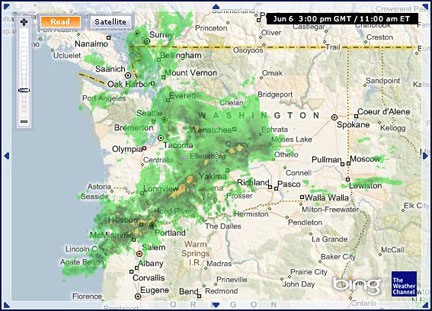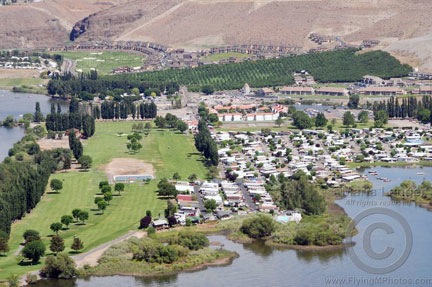What some people will do to make a buck.
The weather forecast last night was clear: there was a 78% change of rain starting at 11 PM. At 8:30 AM, the approaching storm was nearby. It was already raining in Mattawa, where my buddy Jim is working. It looked like the rain in our area would start within an hour.
I called my cherry drying client, who owns a 32-acre orchard 6 NM from where I’m camped. “Looks like it’s going to rain tonight,” I said.
My client was not surprised. This was our third conversation about the weather in 8 hours.
“It’s too late to dry tonight,” I told him. The sun would set in less than 30 minutes and I didn’t dry cherries in the dark. “Sunrise tomorrow is around five. I can be airborne as soon as it gets light.”
“I’ll spend the night down there,” he told me. “I’ll call you at 4:15.”
“I’ll go to bed now then,” I replied.
I hung up, feeling bad for him. He had an old, beat-up RV down in the orchard. I knew he wouldn’t be comfortable. He probably wouldn’t get much sleep. But someone had to be down there to monitor rainfall to know whether I was needed in the morning. Spending the night in an orchard is not part of my job description.
I set an alarm on my iPad for 4:30 and went to bed.
The rain started before 11. Steady but light. I had no trouble sleeping through it.
Wake Up Call
I woke to the sound of birds chirping. It was still dark, but the birds around here don’t seem to care. I grabbed my phone and touched it to bring it to life. It was 4:10 AM. I grabbed my iPad, fired it up, and took a look at the radar on WeatherBug. The storm system was mostly past, but a small blob of rainfall was headed toward the orchard. It could rain itself out before it arrived. Other similar blobs had done so, disappearing off the radar when I put it in motion.
I was studying this when my phone rang. It was my client.
“Is this my wake up call?” I asked cheerfully. I wanted him to know I was already wide awake, on the job — even if I was still in bed.
“Yeah,” he replied. He sounded tired.
“Did it stop raining down there?”
“Yes. Come on out and dry. I won’t be there; I have to get back to town.”
We hung up and I got out of bed. I’d already laid out my clothes, but had neglected to set up the coffee maker. I took care of that, letting it drip into a travel mug while I dressed and washed up. By 4:30, I was slipping out the door with coffee in hand.
Predawn Flight
It was getting light. I could clearly see thick clouds out to the west, in the direction of the orchard. I kept thinking about that little blob of rain.
The helicopter was already fueled and preflighted, so all I needed to do was take off the blade tie-downs and do a walk-around. By 4:45 AM, I was in my seat with the engine running. It took a long time to warm up. My breath quickly fogged the inside of the cockpit bubble. The outside was covered with raindrops.
I spent a bunch of time trying hard to catch a moth that was hitching its second ride in my helicopter. I failed. Again.
By 4:50 AM, I was ready to go. The cockpit bubble was barely clear enough to see through, but I knew how to clear it. I pulled the knobs that turned on the air vent and heat to full. Then I hovered out over the ag strip and took off along it, toward the well-defined horizon to the east. Within 30 seconds, the windscreen was clear, inside and out. I turned to the west and headed toward my client’s orchard.
Out in the distance, a thick blanket of clouds covered the foothills on the other side of the Columbia River. A similar but smaller blanket hovered around 200 feet over the farmland just west of the town of Quincy. Another one poked up from beyond the drop-off I’d have to descend to get to the orchard on the river. I started wondering whether there would be fog on the river itself.
But when I got to the end of the plateau, I could see that the river far below was clear. I pushed the collective down slowly and smoothly, stopping only when I had a descent rate of at least 1,000 feet per minute. I approached the orchard from slightly downriver, as I usually did, but instead of descending to orchard level over Crescent Bar, I made a descending circle over the river. I was hoping to reduce the amount of sound I might project over sleeping people.
I settled into my usual five-foot hover in my usual place beside the water tank and got to work, flying up and down the rows at about 5 knots. Below me, the big, old tree branches went wild, throwing rainwater off the cherries. I varied my pattern only to avoid flying close to the bedroom window on the other side of the house there. I figured that if people were sleeping inside, I’d rather wake them from the other side of the house instead of 20 feet from their window.
The Rain
I was about 1/4 finished with the orchard when it started to rain. I looked up at the clouds floating over me and didn’t really see the rain coming down. But I could see it hitting the river, which wasn’t as smooth and glass-like as it had been when I first arrived. And it was certainly all over my cockpit bubble.
Now my goal is to dry the orchard and it’s pretty hard to ensure that everything I’ve flown over is dry if it’s getting rained on again right after I pass over. Without my client there to tell me what he wanted me to do, I had to do what I thought was right. I had two choices: land somewhere and wait it out and then start again or keep drying and just go over the areas that got rained on after they were dried. Landing wouldn’t have been a big deal — there was a sizable empty boat trailer parking lot nearby where I don’t think anyone would have bothered me at 5:15 in the morning. Still, I had a feeling the rain wouldn’t last and didn’t want to waste time landing and shutting down if I didn’t have to.
My decision to keep drying was based on the amount of rain falling. It seemed like a heavy drizzle. The trouble is, I couldn’t really see when it stopped. Because I was only moving at 5 to 10 knots, there wasn’t enough wind to blow the water off. So it just sat there. When it started dripping off, I figured the rain had stopped. In all, it lasted about ten minutes. I didn’t think the trees I’d already dried had gotten very wet. They certainly couldn’t have gotten soaked. A quick hover over every other row should shake off whatever moisture had settled on them.
But first I needed to finish the rest of the orchard.
This particular orchard is not easy to dry. The trees are a variety of sizes and thicknesses, ranging from very small young trees to very large old ones. There are obstacles. The rows don’t always go the same way and they’re not easy to see. I’m sure I must have whined about this elsewhere, so I’ll spare you any more whining.
The point is, despite the fact that the orchard is only 32 acres, it takes me at least 1.1 hours to dry it. This year, it’s been a lot wetter so it’s taken me 1.2 hours. Today, with the redo of part of it, it took me 1.5 hours. I’m doing it as fast as I can, but I need to be thorough, too. If the grower loses his crop because I did a shitty job drying, he’ll cancel the contract and never use me again. I don’t want that to happen.
Besides, his cherries are the best. I can’t wait until he starts picking.
Return Flight
I It was nearly 6:30 AM when I finished. I took one more low pass over the treetops and headed out over the river. I made my usual spiraling climb at 1200 feet per minute. The plateau was 500 feet above the river level; I needed at least 200 feet more to clear the edge comfortably.

I went back to a viewpoint near Crescent Bar and shot this photo about an hour after I landed. It really was a beautiful day.
As I climbed, I couldn’t help but admire the big, white puffy clouds that were scattered all around me. There was one just to the south of me that seemed to grow out of the top of the Babcock Bench, climbing like stretched cotton toward the sky. The low cloud that had been just west of the town of Quincy was still there, but seemed to have grown. I leveled off at 400 feet above the farmland south of Quincy and the cloud remained below me, as if unsure whether it wanted to be fog or the cloud it really was. I looked out over my shoulder and saw the windmills of the wild horse wind farm, basking in sunlight.
I was angry with myself for not bringing a camera.
I landed at the ag strip and did all the things I usually do: tie down the blades, refuel, do a post-flight inspection. It was about 7 AM when I returned to the RV. I made a second cup of coffee and had the pleasure of drinking all of it. Later, I went out with my camera and tried to capture some of the beauty I’d spotted on my way back.

 The National Weather Service at
The National Weather Service at  When rain is in the area or on the way, I use the
When rain is in the area or on the way, I use the  When I’m out and about and have access to the Internet, I use WeatherBug on my iPad to see weather information, including a radar graphic, forecast summary, and hour-by-hour forecast. I can also use its Webcam images to help judge visibility in the event that I need to cross the Cascades to get to Seattle. (Which I don’t usually do during the season.) WeatherBug is also available for mobile phones; I really do need to get it back on my BlackBerry.
When I’m out and about and have access to the Internet, I use WeatherBug on my iPad to see weather information, including a radar graphic, forecast summary, and hour-by-hour forecast. I can also use its Webcam images to help judge visibility in the event that I need to cross the Cascades to get to Seattle. (Which I don’t usually do during the season.) WeatherBug is also available for mobile phones; I really do need to get it back on my BlackBerry. The helicopter is a quarter mile away and already fueled and preflighted. All I have to do is pull off the blade covers. I can be airborne within 10 minutes of my client’s call. The orchard is a 4-minute flight from here. So I’d much rather sit in my nice warm RV, watching the weather on radar, than sitting out in my truck by the helicopter, blind without most of my weather sources.
The helicopter is a quarter mile away and already fueled and preflighted. All I have to do is pull off the blade covers. I can be airborne within 10 minutes of my client’s call. The orchard is a 4-minute flight from here. So I’d much rather sit in my nice warm RV, watching the weather on radar, than sitting out in my truck by the helicopter, blind without most of my weather sources.


